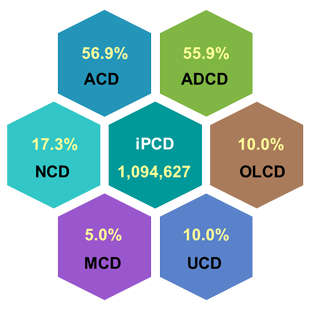Cell death, or more formally programmed cell death (PCD), is critical for development and health of multicellular organisms, and dysregulation of PCD is closely associated with human diseases such as cancer, neurodegenerative diseases and metabolic disorders. Apoptosis, the first identified PCD in metazoans or plants, was reported to physiologically disassemble the cell into apoptotic bodies for elimination, in a caspase-dependent manner (Kerr et al., 1972). Massive autophagy can also trigger a distinct type of PCD, Autophagic cell death (Tsujimoto and Shimizu, 2005). In contrast with traditional consideration as a simple way to die, necrosis has emerged as a regulated form of PCD, necroptosis (Proskuryakov et al., 2003) have been identified. Then, pyroptosis as a novel PCD type is found, that is regulated by caspase-1-mediated cleavage and activation of gasdermin D(Cookson and Brennan, 2001). Moreover, ferroptosis has been reported as a iron-dependent mode of PCD that plays a vital role in many diseases (Dixon et al., 2012). Recently, excess copper also induces a novel form of PCD, named cuproptosis, which is dependent on mitochondrial respiration (Tsvetkov et al., 2022). In addition, other forms of PCDs have been widely studied, such as anoikis (Meredith et al., 1993), oncosis (Fickert et al., 2005), paraptosis (Sperandio et al., 2000) and so on. A comprehensive data resource on the collection, curation and annotation of important regulators involved in these PCDs will provide useful information for further experimental consideration and biomedical design.
Here, we developed iPCD (integrated annotations for Programmed Cell Death) containing 1,094,627 known and computationally predicted regulators for 31 forms of PCDs in 562 eukaryotes. From the literature of PubMed, we curated 6,502 experimentally identified proteins involved in regulating apoptosis, necroptosis/necrosis, autophagic cell death/autophagy, ferroptosis, anoikis, pyroptosis, oncosis, paraptosis, parthanatos, cytotoxic granule-mediated cell death, oxeiptosis, pyronecrosis, alkaliptosis, autosis, lysosomal cell death/autolysis, cornification, entosis, hypersensitive response, mitoptosis, excitotoxicity, NETosis, phenoptosis, heterokaryon incompatibility, mitotic catastrophe, sarmoptosis, wallerian degeneration, oxiapoptophagy, immunogenic cell death, phagoptosis, PANoptosis and cuproptosis from 287 species. According to the morphology or mechanism of PCD, we divide it into six categories: apoptotic cell death (ACD), necrotic cell death (NCD), autophagy-dependent cell death (ADCD), other lysosomal cell death (OLCD), mitochondria-associated cell death (MCD), and unclassified cell death (UCD). Also, orthologous searches were performed in 562 eukaryotes. Moreover, we carefully annotated the regulators of eight model organisms with the knowledge from additional 102 public resources that cover 16 distinct aspects, including (i) Genetic variation and mutation; (ii) Functional annotation; (iii) Structural annotation; (iv) Physicochemical property; (v) Functional domain; (vi) Post-translational modification; (vii) Disease-associated information; (viii) Protein-protein interaction; (ix) Drug-target relation; (x) Orthologous information; (xi) Biological pathway; (xii) Transcriptional regulator; (xiii) mRNA expression; (xiv) Protein expression/proteomics; (xv) Subcellular localization and (xvi) DNA & RNA element. The database will be updated routinely as new iPCD proteins are reported.

 |
|
For publication of results please cite the following articles:  iPCD: A Comprehensive Data Resource of Regulatory Proteins in Programmed Cell Death
iPCD: A Comprehensive Data Resource of Regulatory Proteins in Programmed Cell Death Dachao Tang, Cheng Han, Shaofeng Lin, Xiaodan Tan, Weizhi Zhang, Di Peng, Chenwei Wang and Yu Xue. Submitted. |
 |



